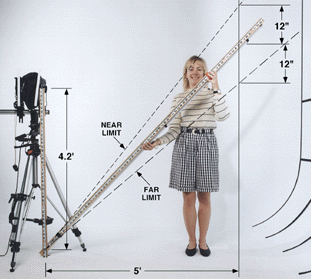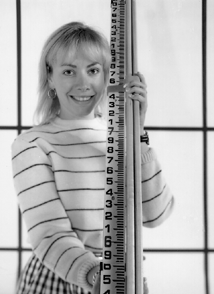

This is one of the illustrations from Part 2 of View Camera Focus
and Depth of Field . It shows a view camera being used to photograph
a standing subject (Lisa). The 150 mm lens on the view camera is tilted
forwards by 7 degrees (erroneously noted a 4 degrees on this page earlier).
Since the camera back is vertical, the Hinge Rule puts the Hinge Line 4.2
feet directly below the camera lens. By focusing the view camera on Lisa's
chin, we have put the plane of sharpest focus along the surveyor's rod -
that is, along a line joining the hinge line with Lisa's chin. The dashed
lines show the limits of depth of field.
The camera is a Sinar F fitted with a bag bellows. The camera back is vertical.
The lens is a Schneider 150/5.6 Symmar set to f/11.
The front standard is tilted forwards by 7 degrees.
The 7 degree forward tilt, in conjunction with the 150 mm focal length of
the lens, put the location of the Hinge line 4.2 feet directly below the
lens. The Surveyor's rod also has a hinge at this point.
The sloping portion of the Surveyor's rod indicates the position of the
plane of sharpest focus.
The rules of view camera depth of field say that at a distance one hyperfocal
distance in front of the camera (in this case about 20 feet) the depth of
field measured in a direction parallel to the film plane will be equal to
the lens-to-Hinge Line distance: 50 inches (4.2 feet). Thus at a distance
5 feet in front of the camera, the depth of field should be 12 inches either
side of the plane of sharpest focus. (The diameter chosen for the acceptable
circle of confusion was in this case taken to be the size of the smallest
half-tone dot used for magazine reproduction (0.3 mm). This is three times
the usual photographic standard. But it is appropriate for the purposes
of the magazine illustrations.)
The dashed lines indicate the near and far limits of depth of field using
the criteria chosen for this article (not the usual standards) as explained
above.
The photograph was taken in the Robinson-Campbell Studios in Halifax, Nova
Scotia.
The result, obtained on Polaroid P/N 55 film, is shown below:

This all seems quite straight forward, but the actualViewCamera
magazine article will show you another example
which is not nearly so!
Back to View Camera Depth of Field.
Back to Table of Contents.